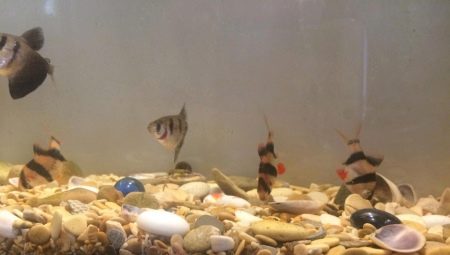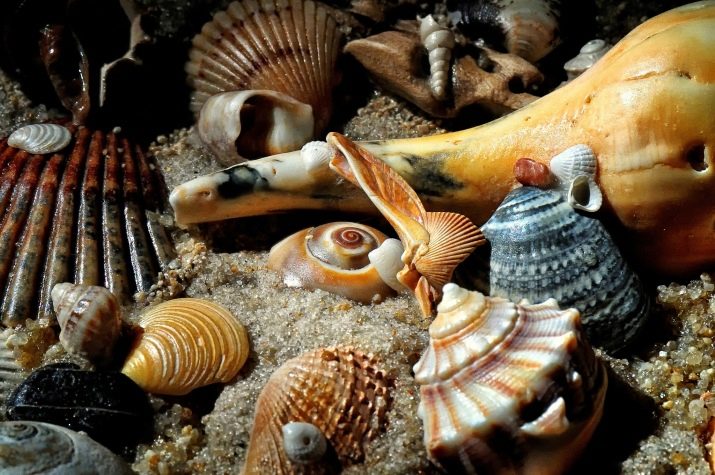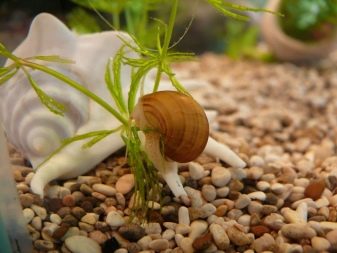Shells in the aquarium: benefits, harms and recommendations for use

Some aquarists want not only to have fish, but also to make the aquarium as similar as possible to the seabed. Shells will help to add authenticity to the design. Moreover, some beginners believe that you can simply put sea shells, they say, they do not harm the inhabitants of the depths, which means that you can collect them yourself on the beach and add them to the water. This statement is only partly true, so we will try to comprehensively consider how such seafood will affect the condition of the inhabitants of an artificial reservoir.



Advantages and disadvantages
So, the main question is whether or not you can put shells in the aquarium, but there is no definite answer to this question. The fact is that in a freshwater aquarium, such decorations can be beneficial or harmful - it all depends on what kind of living creature you live in. Let's try to figure out what is more in each case.
It is customary to start with a good one, so let's consider how adding shells to an aquarium is useful.
- Decorativeness. This is not exactly a useful factor, it is just that people thinking about adding seashells from the beach to an artificial pond usually care first of all about the aesthetic appeal of the aquarium environment. This cannot be denied, provided that the person also tried to correctly arrange such decorations.

- Elimination of calcium deficiency. The shell consists of calcium carbonate, that is, its chemical composition is very close to chalk and limestone. Now you understand why mollusks need this mineral, but fish, which need it to form bones and scales, and even some plants, actively use it to build an organism.
If there is not enough of this substance in the water, there is nothing to expect that the pets will grow up healthy, and there is nowhere to get calcium in soft water. Someone adds chalk, and you can throw in some seashells - just be prepared that they will dissolve over time.

- Additional refuge. There are species of fish that like to hide - both in everyday life and for the same spawning. It is often difficult to find a secluded spot in an aquarium, but a rather large shell would be an ideal haven for a "shy" woman.

After the above, many probably decided to add seashells, but there are actually much more possible disadvantages than advantages. It must be admitted that with a proper understanding of the processes taking place in the aquarium, adding such an element can only bring one benefit, but first you need to make sure that you do not only make it worse.
- Excessive rigidity. By the way, although calcium is useful, not all inhabitants like too hard water - it's no secret that even something useful in case of an overdose is harmful. Plants are usually more sensitive to increased rigidity than fish, but the former can perform an important function in the home ecosystem, and among the latter, the haracin, for example, stop spawning from such changes.
If the water in your aquarium is, in principle, hard, then the added shells will not make it worse; with slightly alkaline water of medium hardness, you can decorate the aquarium with them only in moderation, but soft and slightly acidic water will rapidly dissolve calcium, acquiring a potentially dangerous hardness for some species.
If there is a lot of carbon dioxide in the container, or if you add pH-lowering agents, the shells will dissolve even faster.

- The inhabitants of the aquarium can cut themselves and get stuck. A curious fish loves to approach the shells and even hide in them, but here everything happens as with children, who sometimes play with things that are not intended for this at all. Avoid placing sharp-edged specimens in the pond, as fish can also injure themselves and be difficult to treat.
Another problem is that a curious pet sometimes swims inside the curl, but cannot return and die because of this. This kind of trouble especially often happens with catfish, because experienced aquarists advise to put shells in the aquarium only with the entrance down, so that they cannot be entered.

- Excessive synthetics. Naturally, in decorative terms, it is not those small shells that are found on the beach that look much prettier, but those large ones that are sold in souvenir shops. You need to understand that the seller wants to bail out the maximum amount of money for his product, because his shells are especially attractive due to an additional layer of paint or varnish.
In a sense, the consumer himself should benefit from this, since the souvenir in this form will probably last longer, but if you guess to throw such an ornament into the water, then do not be surprised why the fish floated upside down.

- Aesthetic incompatibility. The unbridled pursuit of beauty often leads to the owner of the aquarium being overzealous. Many domestic fish live in freshwater and are not surrounded by tropical vegetation, but the tropical-glamor-hungry beginner is often eager to shove the most impressive exotic shell inside.
Over time, the understanding comes that the inconsistency of the surroundings spoils the impression of the decoration itself, and if it was also valuable for you as a souvenir, you can easily lose it - remember that the shell gradually dissolves.

How to use it correctly?
The first thing you should have done after reading the list of shortcomings in the previous paragraph is to think about whether, in general, shells are needed in your home underwater world. You must be sure that this decoration does not make it worse., which means that you should make sure that your pets are definitely not against hard water, and even from the tap it flows from you far from in the softest form. Only in this case is it worth continuing to think about adding such a decoration to the aquarium.
Next, you need to think about exactly how you want to design a new aquarium design, since simply throwing in a few shells will not make the underwater world more beautiful than it was before. In most cases, experienced aquarists will sketch out a plan for how to set up their little pond.
If you think about it, this is not such a bad idea - you will clearly know what kind of shells you need, how much, and if it will harm the inhabitants of the aquarium in the end.


If you got down to business with real avidity and want your masterpiece to be liked not only by yourself, but also by experienced colleagues, it makes sense to decorate an artificial reservoir not only with shells, but also with other elements of a typically marine environment.
Today specialized pet stores sell many different accessories that can complement the look of the container and turn it into a corner of an almost real seabed. These include the shells themselves - both small and large, but completely safe for fish, and various imitations of wrecks of sunken ships, and picturesque "driftwood", and much more.
For those who are not ready to reinvent the bicycle, but definitely want to add a marine touch to the design of their aquarium, there is a good idea, which, however, assumes that your pets will definitely not be hurt by the abundance of such decorations.
The idea is to evenly sprinkle the bottom with small shells and add brighter and more interesting large specimens only in a few places.

How to process the material?
As you may have already understood, the very fact that you saw an attractive shell does not mean that it can be immediately sent to the aquarium - decide on such a step and then you will regret the consequences for a very long time.
Remember once and for all that decorative remains of mollusks sold in the souvenir markets of any major resort are extremely risky to send to a living ecosystem - you may not see it, and the product will be tinted or varnished. It is unlikely that it will be possible to "prepare" such an accessory - it is simply not intended for such an application and you should not experiment with it.
If you really want to add a natural, marine aesthetic to your aquarium, it would be most prudent to contact your nearest pet store. Such outlets sell not only containers, fish and food for them - in the assortment you can usually find various decorations, among which there are both natural shells and skillful imitations, which, by the way, will not in any way affect the hardness of the water and the health of the ecosystem.
The good thing about the goods here is that they do not need to be prepared at all - even if you chose a sample that was once really a living mollusk, you can count on it to be completely safe for the underwater world.



If you are a supporter of economy, you can personally get shells from the sea and add them to the aquarium, but then the preparation of the selected material falls on your shoulders. First of all, you must be sure that the shell remains uninhabited for a long period and in front of you is not a corpse, but a long-empty skeleton.
If the remains of the mollusk that lived there are still preserved inside, this may not benefit the fish - you do not know why the creature died, and whether harmful bacteria have gathered on carrion that can poison the flowering ecosystem of your aquarium. Seeing that the carapace is not completely released, it is better not to try to tinker with it, but simply throw it away, replacing it with another.
Even if the shell is absolutely empty, but you picked it up in nature, this leaves a certain chance that potentially dangerous microorganisms are present on it.capable of disrupting the biological balance. To avoid their penetration into the aquarium, you should first take a good walk on the surface with a brush, trying to get as far inside as possible. After that, the shell should be boiled over low heat for three hours to ensure that all extraneous animals are killed.
Even after boiling, the shells are still not ready for entering an artificial reservoir - they need to be kept in cool water for about a day and only then can they be used as decoration.


The following video will tell you about shells for an aquarium.








